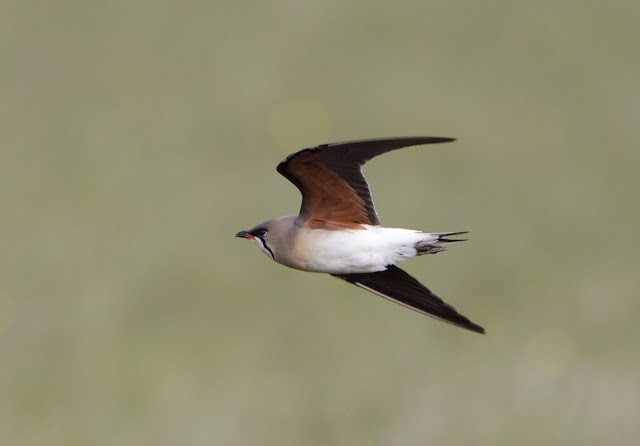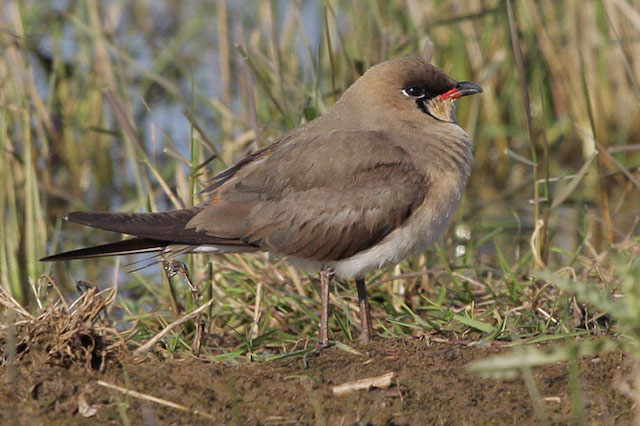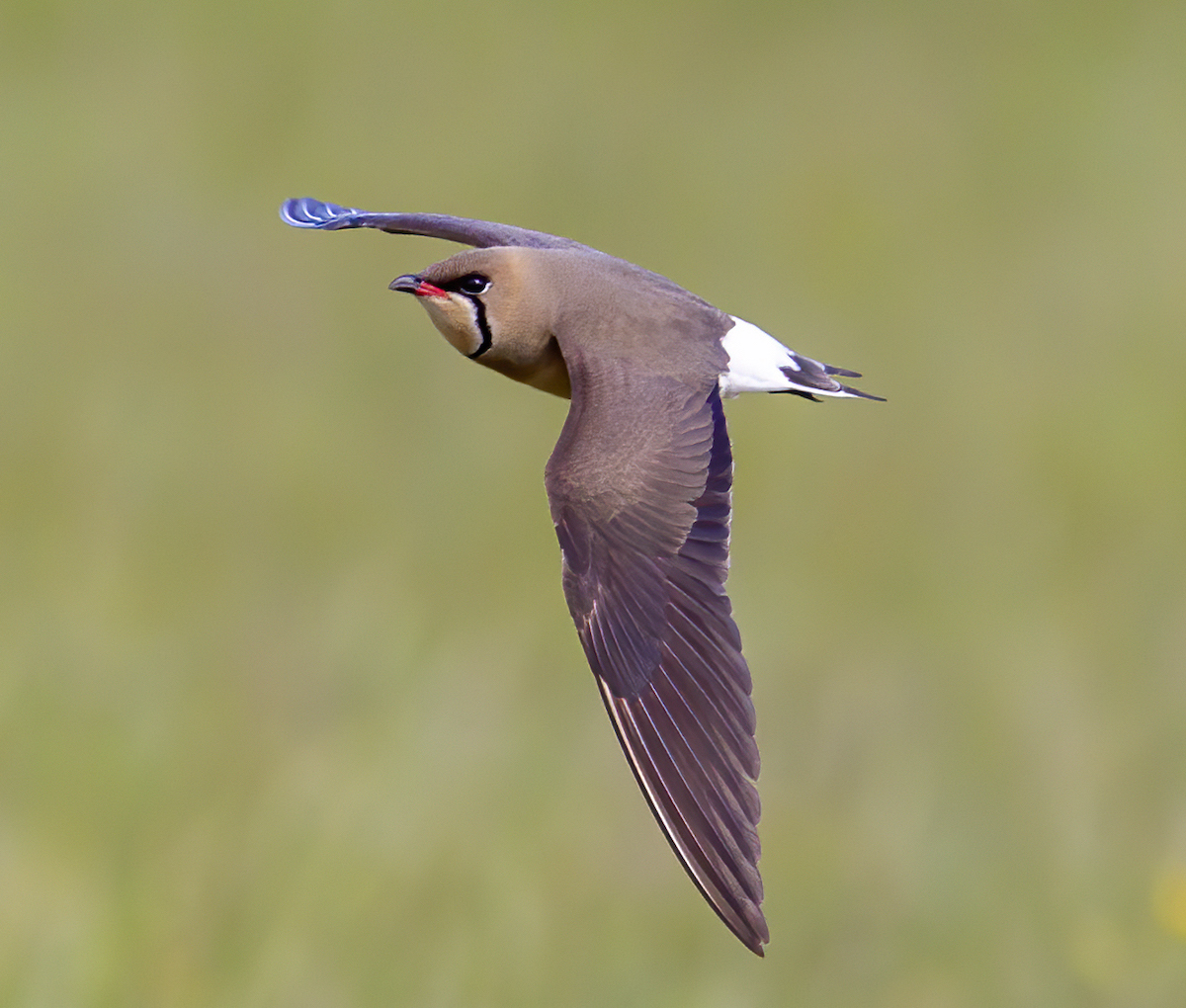Oriental Pratincole Glareola maldivarum



An adult Oriental Pratincole was present at Frampton Marsh RSPB reserve May 9th-19th 2010. The bird gave very good views for up to 4,000 visiting birdwatchers during its stay on the reserve. This constituted the 7th record of Oriental Pratincole for the UK (up to 2020) and the first for Lincolnshire. This follows the 6th record in Kent and Sussex in May-June 2009 and may conceivably have been the same returning bird.
A recent BOU review (2024) of a specimen at National Museums, Scotland, BOU accepted a 2CY+ bird, found in July 1908 at Eilean Mòr, Flannan Isles, Outer Hebrides, as the first British record. The second record came Jun 1981 (Suffolk and later Essex) but only accepted after lengthy debate and eventually published in the BBRC report of 1988. The bird in question was a 2CY bird which later in its stay suffered at the hands of some severe rainfall which obscured some of its main plumage features. It was also seen later in Essex. The Frampton bird presented no such problems being a pristine adult in near perfect plumage. It also followed an established pattern of turning up in the spring in the south-eastern quarter of England.
Oriental Pratincoles breed from northern Pakistan and Kashmir into China, wintering in south-east Asia and Australia. North-eastern populations are long-distance migrants and return north to breed in East Asia May-Aug and are common migrants in central and north-eastern China. The mechanism of the species vagrancy to Britain is speculative but is presumed to relate to wandering juveniles finding their way to Africa in their first autumn and subsequently migrating north with Collared Pratincoles G. pratincola. Might it also be possible that some birds from China undertake the long migration into Africa similar to that seen in Amur Falcons Falco amurensis? Recent estimates put the wintering population of Oriental Pratincoles in south-east Asia to Australia at 2,880,000 birds with up to 1,000,000 wintering in the Indian sub-continent where they are largely a short-distance migrant.
Up to 2018, there have been 20 records in the Western Palaearctic although there is likely to be some duplication as birds moved around: Cyprus (April 1993), Egypt (April 1993), Finland (July 2017), France (May 2014), Israel (October 1999), Kuwait (two, April 2008), Netherlands (August 1997, September 2014), Sweden (July-October 2001, May 2017, May 2018), Norway (August 2009, May 2018), and United Kingdom (June 1981, June 1988, May 1993, September 1993, May 2009, June 2009, May 2010).
| Site | First date | Last date | Count | Notes |
| Frampton Marsh | 09/05/2010 | 19/05/2010 | 1 | Adult. |
Oriental Pratincole, Glareola maldivarum, at RSPB Frampton Marsh nature reserve, May 9th, 2010, first county record.
by Phil Hyde, Paul Sullivan, and John Badley
Introduction
On Sunday May 9th, Wayne Lawrance, a Grimsby birder, found a Pratincole hawking insects distantly over the scrapes near the East hide at RSPB Frampton Marsh nature reserve, noting the reddish-brown under wing coverts (thus ruling out Black-winged Pratincole). As he only had binoculars with him, he could not get further details and reported his sighting as a probable Collared Pratincole to the visitor centre.
Alerted by RSPB staff Paul Sullivan had brief, distant flight views but the bird appeared to land out of view near to the East Hide. Paul Sullivan, now joined by Phil Hyde hastened there, and within minutes the Pratincole reappeared. It flew back and forth very quickly before dropping down out of sight again on to one of the many grassy islands on the scrape. The reddish-brown under wing was again noted ... but there was no sign of a clear, white trailing edge to the secondaries that should have been shown by Collared Pratincole and furthermore the tail was short and stubby. The dawning realization chat it might be an Oriental Pratincole was confirmed a short while later when, having been joined by John Badley (with whom PH/PS had been discussing the bird's identification on the phone), the bird re-appeared. It flew close past confirming the lack of a broad white trailing edge to the secondaries and a very short tail. The rare bird news services were duly alerted, and a steady stream of birders began to arrive.
General appearance and structure
Size and overall appearance. Similar in size to Arctic Tern, Sterna paradisaea. Showed long, pointed wings and a short, stubby forked tail. Dark brown above with white rump & upper tail. The underwing showed reddish-brown coverts with dark brown primaries. Under body showed whitish belly, peachy-brown breast and throat with black necklace outlining ochre-yellow throat. The swift, agile & twisting flight over water recalled some of the smaller gulls, Larus sp, and even the smaller skuas, Stercorarius sp. When at rest, the bird appeared particularly long legged, and the tail fell several millimetres short of the length of the primaries.
Detailed description.
Head: Fawn-brown crown, but with nape slightly warmer, yellower-brown than mantle. The neck was colder brown, similar in colour to the mantle. The throat was pale yellow and outlined in black; a thin white line could be seen inside the inner part of this black "necklace". Lores blackish.
Upperparts: Evenly coloured medium to dark brown mantle (depth of colour varied according to angle and light) and upper wing coverts, with darker, contrasting blackish primaries. Pure white uppertail coverts and rump, with black-tipped white rectrices. The black tips of the outer tail feathers was more restricted than would be expected for Collared Pratincole. There were no clearly defined white tips to the secondaries, so the upper wing did not have an obvious white trailing edge that is characteristic of Collared Pratincole, G. pratincola. However, at close range and in good light it was clear chat the secondaries were very finely tipped white. There was no contrast between the inner and outer secondaries as is typical for Oriental but not in Collared.
Underparts: Cold brown throat band below the black necklace line, with a warmer, peachy wash separating this from the all-white lower breast and belly. Undertail coverts pure white.
Bare parts colouration: Bill - upper mandible all black but with bright red base. Lower mandible black with a red base. The oval-shaped nostril, diagnostic for this species was observed when on the ground at close range and can be seen in several photos. Legs and feet were a uniform brownish grey.
Discussion
Thanks to the co-operation of the bird and the many excellent photographs taken it is possible to see almost all of the identification features of Oriental Pratincole highlighted in the authoritative paper 'Identification of Collared Pratincole and Oriental Pratincole - a critical review of characters' by Gerald Driessens and Lars Svensson, Dutch Birding 27: 40-41 2005.
Pratincoles are birds of open country, often seen near water, hawking for insects. Oriental Pratincoles breed from Northern Pakistan and the Kashmir region across into China and south-west. They are migratory, wintering in Pakistan, India, Indonesia, and Australasia. Although still an extreme rarity in the Western Palaearctic (WP), flocks numbering into the millions have been recorded in coastal Australia on the wintering grounds.
The first record for the Western Palearctic was in Suffolk/Essex in June 1981. There have been subsequent UK records in Kent (1988), Norfolk (1993), East Sussex (1993), Suffolk (1993) and West Sussex/Kent/Oxfordshire (2009). This constituted the 1st record for Lincolnshire and the 7th record for the UK.
Although only just a year old, the new large freshwater scrapes at RSPB Frampton Marsh have now attracted two of the three species of Pratincoles recorded in the UK. The first was a Collared Pratincole (August 2009) and the first in Lincolnshire since 1975. Over 4000 people visited RSPB Frampton Marsh in the first eight days of the bird's stay.
References
Hyde, P., Sullivan, P., and Badley, J. (2010). Identification of the Oriental Pratincole in Lincolnshire. Birding World 23(5), 209-214.
Hyde, P, Sullivan P and J Badley. Finders Reports 2010. Oriental Pratincole. Lincolnshire Bird Report 2010, 171-2.
Rogers, M.J. and the Rarities Committee. Report on rare birds in Great Britain in 1988. British Birds 82, 505-563.
(Account as per new Birds of Lincolnshire (2021), included September 2022; text updated August 2024)

